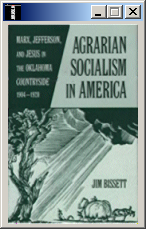http://www.rhci-online.net/radiogram/radiogram.htm
http://www.rhci-online.net/radiogram/radiogram.htm
|
RSID: <<2018-07-25T20:25Z MFSK-32 @ 6070000+1500>>
START IBC - ITALIAN BROADCASTING CORPORATION
mail: ibc@europe.com "IBC DIGITAL" "IBC DIGITAL" Sending Pic:200x127;
SANTA MARIA DEL FIORE -
FLORENCE - ITALY
|
|
|
RSID: <<2018-07-28T15:30Z
MFSK-64 @
9400000+1500>>
|
|
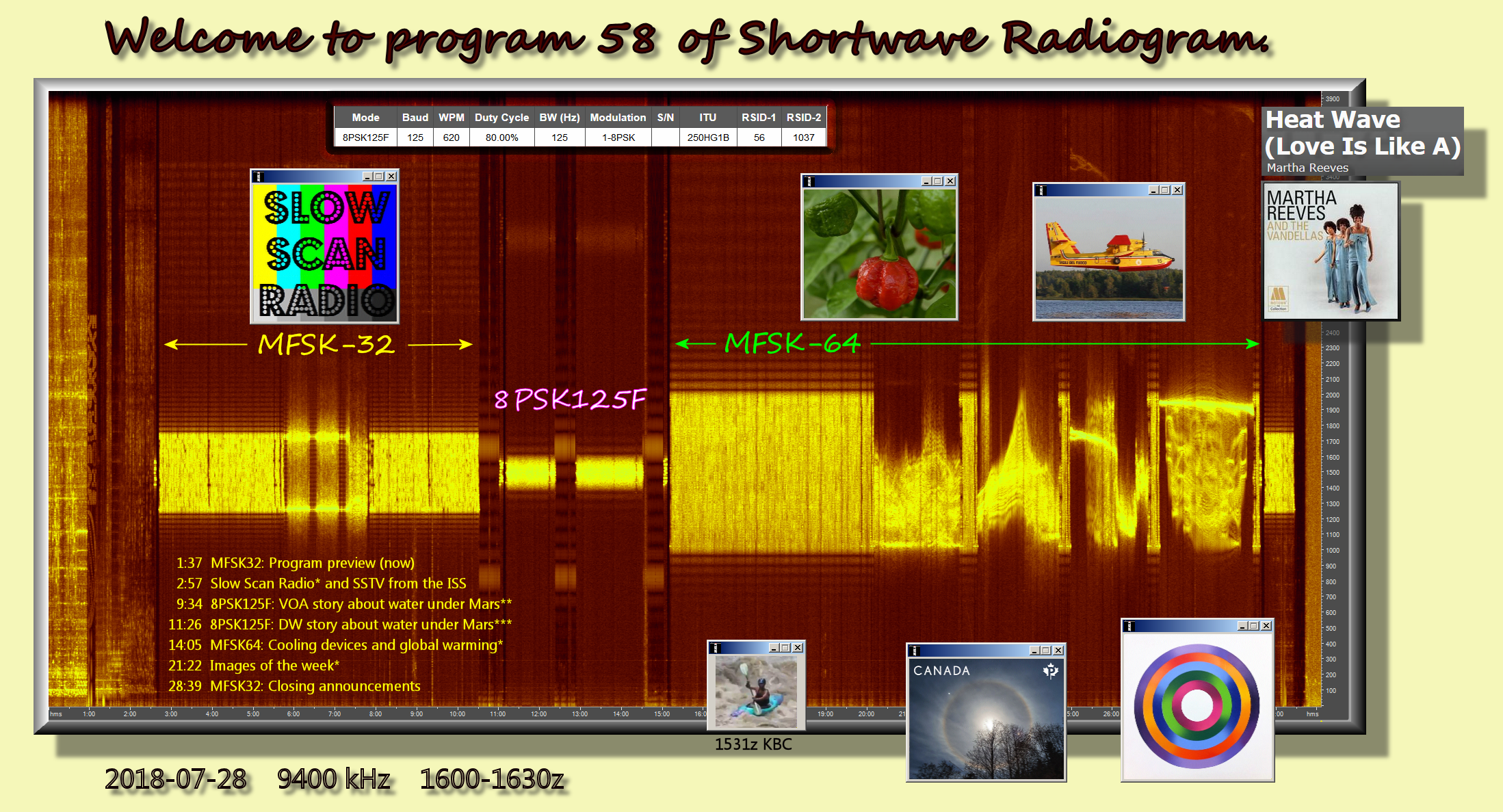
RSID: <<2018-07-28T16:01Z MFSK-32 @ 9400000+1500>>
Welcome to program 58 of Shortwave Radiogram.
I'm Kim Andrew Elliott in Arlington, Virginia USA.
Here is the lineup for today's program in modes as noted:
1:37 MFSK32: Program preview (now)
2:57 Slow Scan Radio* and SSTV from the ISS
9:34 8PSK125F: VOA story about water under Mars**
11:26 8PSK125F: DW story about water under Mars***
14:05 MFSK64: Cooling devices and global warming*
21:22 Images of the week*
28:39 MFSK32: Closing announcements
* with image(s)
** Use AM mode
*** Use USB or LSB modes if available
Please send reception reports to
radiogram@verizon.net
And visit http://swradiogram.net
Twitter:
@SWRadiogram
"Slow Scan Radio"
A new radio program providing text and images via analog
shortwave broadcasting is "Slow Scan Radio," produced by John
Piek, PA0ETE.
As the name implies, the show features images in various SSTV
modes. The SSTV images can be decoded using software such as
MMSSTV from
http://hamsoft.ca/pages/mmsstv.php and the
receive-only RXSSTV from
http://users.belgacom.net/hamradio/rxsstv.htm .
Slow Scan Radio also has text in various modes. Several MFSK and
PSK modes were included on the first broadcast on 25 July.
The schedule is Wednesdays at 1830-1900 UTC on 6070 kHz from
Channel 292 in Germany. On 8 August, a special one-hour edition
of "Slow Scan Radio" will begin 30 minutes earlier, at 1800 UTC,
so that Channel 292 can test one antenna from 1800-1830 UTC and
another from 1830-1900 UTC, both on 6070 kHz.
The website of Slow Scan Radio is
http://www.slowscanradio.com
and reception reports can be sent to John at x@xdv.me
.
Image: Logo of Slow Scan Radio ...
Sending Pic:210x200C;
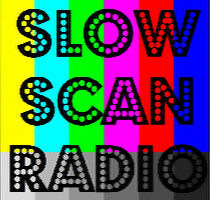
And on the subject of SSTV ...
From arrl.org
Slow-Scan TV Transmissions from International Space Station Set
for July 30 – 31
25 July 2018
Russian cosmonauts on the International Space Station are
expected to activate Amateur Radio Slow Scan Television (SSTV)
transmissions on 145.800 MHz FM on July 30 and 31 The SSTV
experiment should be active on Monday, July 30, 1600 – 1930 UTC,
and Tuesday, July 31, 1325 – 1915 UTC, using the RS0ISS call
sign. SSTV images will be transmitted using the Kenwood TM-D710
transceiver in the Russian ISS Service Module. Format is expected
to be PD-120.
http://www.arrl.org/news/slow-scan-tv-transmissions-from-international-space-station-set-for-july-30-31
See also:
https://amsat-uk.org/beginners/iss-sstv/
This is Shortwave Radiogram.
Please send reception reports to
radiogram@verizon.net
Next on Shortwave Radiogram is an experiment.
Because 8PSK125F involves phase shift keying, any difference in
the lower versus upper sideband could disrupt the phase
modulation. For this reason, our hypothesis is that the decode
will be better in a single sideband mode (USB or LSB) than in AM,
which opens the possibility of clashing sidebands.
To test this hypothesis, we will send content twice, first for
reception in AM, and later for reception in an SSB mode.
If your receiver is not already in the AM mode, please switch to
AM for the next content in 8PSK125F (30 seconds will be provided)
...
Shortwave Radiogram now changes to 8PSK125F
RSID: <<2018-07-28T16:10Z
8PSK-125F @
9400000+1500>>
This is Shortwave Radiogram in 8PSK125F ...
Scientists Discover What Appears to be Water Beneath the Surface
of Mars
VOA News
Scientists announced Wednesday they had discovered what appears
to be a body of salty, liquid water beneath the surface of Mars,
raising the possibility of detecting life on the Red Planet.
The reservoir, spanning about 20 kilometers in diameter under ice
on the planet's southern pole, was found through a radar
instrument on the Mars Express Orbiter, which was launched in
2003.
Researchers previously discovered signs that water once flowed on
Mars.
“It’s tempting to think that this is the first candidate place
where life could persist [on Mars],” said Roberto Orosei, a
professor with the Italian National Institute for Astrophysics.
He led the research published in the journal Science. He also
said Mars may contain hidden bodies of water that have yet to be
discovered.
Orosei said the size of the reservoir "really qualifies this as a
body of water," like a lake, and not like "some kind of melt
water filling some space between rock and ice."
The scientists say the discovery gives them a roadmap to
potentially finding life under the surface.
"We are not closer to actually detecting life," said Dr. Manish
Patel, an astrobiologist at Britain's Open University, in
comments published by the BBC. "What this finding does is give us
the location of where to look on Mars. It is like a treasure map
- except in this case, there will be lots of 'X's marking the
spots."
Mars is cold, barren and dry, but used to be warm and wet. The
researchers say the water in the lake might have been kept from
freezing due to a high concentration of salt. One scientist who
was not involved with the study said microorganisms have been
able to survive in similar conditions on Earth.
https://www.voanews.com/a/water-is-buried-beneath-martian-landscape-study-says/4499183.html
Please now switch to USB or LSB (if available on your radio).
Thirty seconds will be provided ...
From Deutsche Welle:
Life on Mars? Planet has an underground lake of liquid water, say
Italian researchers
25 July 2018
Mars has a 20-kilometer (12.4-mile) wide lake some 1.5 kilometers
underneath its surface, according to a study published in the US
Science magazine on Wednesday and conducted by a team led by
Roberto Orosei from the National Institute of Astrophysics in
Bologna.
The spectacular find ends decades-long debate on the existence of
liquid water on Mars. Liquid water is a key condition for life as
it exists on Earth.
Astronomers have long known that Mars used to have rivers and
oceans of liquid water billions of years ago, based on, among
other things, flowing patterns on the planet's surface. More
recent discoveries confirmed the presence of ice in its polar
regions and water vapors in the planet's thin atmosphere.
NASA's Phoenix module also registered snow and, possibly, water
droplets falling in 2008. There are also hints that small amounts
of liquid water could temporary build up in a thin layer below
the Mars' surface.
The latest find, however, relies on radar information gathered by
the Mars Express mission by the European Space Agency (ESA). The
data shows a region of a uniform radar signature close to the
south pole of Mars, which the Italian researchers claim to be a
hidden lake.
A total of 29 sets of radar samplings showed a "very sharp change
in its associated radar signal," allowing scientists to map the
outlines of the lake.
"The radar profile of this area is similar to that of lakes of
liquid water found beneath the Antarctic and Greenland ice sheets
on Earth, suggesting that there is a subglacial lake at this
location on Mars," said the report.
Too cold for a swim
Scientists believe the lake consists of liquid water, despite
having an estimated temperature of –68 degrees Celsius (-90.4
Fahrenheit). This is possible if the lake has a large content of
salt which significantly changes the freezing point.
The team lead by Orosei now speculates about the presence of life
in the lake, comparing to similar locations on Earth, which are
found below Antarctic and Greenland. Researchers have found life
in an underground lake in the Arctic, dubbed Lake Whillands, but
only on microbe-level.
Separately, NASA's Curiosity rover found "organic materials" on
Mars last month. While the presence of organic molecules does not
prove life, it points towards a "habitable environment" on the
neighboring planet.
Currently, NASA is working on a mission to send humans to an
asteroid near Mars in 2025 and land a human team on the planet
sometime in the 2030s.
https://www.dw.com/en/life-on-mars-planet-has-an-underground-lake-of-liquid-water-say-italian-researchers/a-44820915
You may now switch to your choice of AM or USB or LSB. Thirty
seconds will be provided ...
Shortwave Radiogram now changes to MFSK64 ...
RSID: <<2018-07-28T16:14Z MFSK-64 @ 9400000+1500>>
This is Shortwave Radiogram in MFSK64
Please send reception reports to
radiogram@verizon.net
From Deutsche Welle:
How to prevent cooling from warming up the world
Air conditioners and other cooling devices are critical for
millions of people worldwide, particularly with rising
temperatures. But while these appliances can save lives,
they're also big contributors to global warming.
Irene Banos Ruiz
20 July 2018
On hot days, many of us automatically turn on the air conditioner
or reach for a cold drink from the fridge without thinking twice
about it. But access to these kinds of cooling devices -
something millions of people around the world still lack - can
actually be a matter of life and death.
Cooling is key to ending poverty and hunger. With refrigeration,
for example, we can store medicines and reduce food waste.
Cooling is also vital to improving health and wellbeing. In
short, to achieving sustainable development. Yet it entails great
risk: as the use of cooling products increases, so too do global
emissions, which contribute to global warming. The result is a
vicious circle.
The number of cooling devices is expected to quadruple to 14
billion worldwide by 2050, researchers show. Without greening the
sector, emissions would skyrocket and take us far from reaching
the 2-degree target set in Paris.
"If climate change were not an issue, it's safe to say that
access to cooling would be like access to clean water or
sanitation," Mark Radka, head of the Energy and Climate Branch of
UN Environment's economy divison, told DW.
But since unfortunately climate change is an issue, granting
access to cooling without further damaging the planet and its
population remains a huge challenge.
Food grains in India (DW/P. Mani Tewari)
Cooling is a must
More than a billion people, mainly in Asia and Africa, are at
risk from lack of access to cooling, according to a new report
from the Sustainable Energy for All (SE4ALL) initiative. The 30
hottest cities in the world are in developing countries, which
are already suffering the most from climate change.
"As populations grow and temperatures reach new records, the
health and economic risks associated with lack of access to
sustainable cooling are growing exponentially," Rachel Kyte,
director and Special Representative to the United Nations
Secretary-General for SE4ALL, told DW.
In India, for instance, almost 20 percent of health care products
that depend on cold supply chains, such as vaccines, arrive in an
unsatisfactory state. Nearly half a million people worldwide die
every year from foodborne illness, or diseases caused by
contaminated food. Insufficient cooling is a main reason for
that, the World Health Organization says.
A lack of cooling also deepens poverty in developing countries,
where farmers regularly lose about 40 percent of their harvest
due to inadequate storage, according to the World Food Programme.
The same happens with fish, which only lasts a couple of hours
without refrigeration. This impedes small retailers from reaching
more lucrative markets and growing.
"The more you can establish a cold chain and maintain food cold,
the farther you can go and the greater economic value you can
get," Radka said.
Access gaps to cooling also affect productivity at work and study
places.
Warming up the planet
Air conditioners and refrigerators typically use
hydrofluorocarbon gases (HFCs), refrigerants that do not damage
the ozone layer but cause a global warming effect up to 23,000
times greater than carbon dioxide (CO2).
By 2050, HFCs are expected to be responsible for around 12
percent of all global warming. The binding international
agreement Kigali Amendment, which enters into force in January
2019, aims to reduce HFCs by more than 80 percent over the next
30 years.
However, cooling technologies also use a significant amount of
energy - mainly from fossil fuels - which contributes even more
to air pollution. In 20 years, air conditioning systems could
account for 40 percent of electricity consumption in Southeast
Asia.
Air pollution is expected to cause about 13,000 additional deaths
per year by mid-century, about a thousand of them due to air
conditioning, a new study of current air conditioner use in the
United States estimates.
"When we turn the air conditioners on inside to adapt to the heat
outside, we're creating pollution at the power plants that are
burning coal and gas," David Abel, lead author of the study, told
DW. As long as we rely on fossil fuels, we'll address the heat
problem while at the same time contributing to another problem,
air pollution, he added.
A sustainably cooled world
Breaking the vicious circle would likely have to involve the
rapid reduction of HFCs and of fossil fuels. Producing more
efficient cooling devices wouldn't hurt either.
More efficient products can massively reduce emissions regardless
of the energy source, Brian Holuj, program officer at UN
Environment's United for Efficiency initiative, told DW.
"It's one of the fastest, cheapest and cleanest ways to reduce
emissions around the world and reach the Paris targets," he
added.
But such a transition requires policy-makers to incentivize
manufacturers and buyers. Most countries could increase
efficiency by at least 30 percent for air conditioners and 60
percent for household refrigerators. Therefore, "the key
challenge is not a lack of technology, it's a lack of good policy
and awareness" Holuj said.
Yet small moves help too. Keeping cooling devices clean, painting
roofs white to reflect sunlight or creating wind corridors to
allow heat to escape are little tricks to keep our planet from
getting hotter. And, of course, reducing our consumption.
"Just becoming aware of this issue is important," Radka pointed
out. "We all tend to think as individuals and not about what
happens if our behavior is multiplied by a billion people."
As a final remark, Kyte concludes that for a sustainable world to
become reality, we must bear in mind that "access to cooling is
not a luxury, it's a human right."
https://www.dw.com/en/how-to-prevent-cooling-from-warming-up-the-world/a-44734986
Accompanying photo: While you're building your rooftop garden,
you also might want to consider planting some chili. That's
because spicy food, believe it or not, can keep you cool. It
forces you to sweat, lowering your body temperature. ...
Sending Pic:222x188C;

This is Shortwave Radiogram
Please send reception reports to radiogram@verizon.net
THIS WEEK'S IMAGES
A new set of weather-themed postage stamps in Canada includes
this one showing a moon halo in Whistler, British Columbia,
caused by airborne ice crystals refracting moonlight. From
bit.ly/2OjAUus ...
Sending Pic:226x176C;
After serving in Sweden, Italian fire fighting planes head to
Greece to help another EU country. From
bit.ly/2v7SKHX
...
Sending Pic:215x176C;
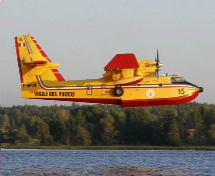
The painting of the week is acrylic, five floating circles by
Colin McNaught. From
https://colinmcnaughtart.com/small-paintings/
Sending Pic:216x212C;
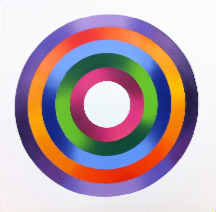
Shortwave Radiogram now returns to MFSK32 ...
RSID: <<2018-07-28T16:28Z
MFSK-32 @
9400000+1500>>
This is Shortwave Radiogram in MFSK32 ...
Transmission of Shortwave Radiogram is provided by:
WRMI, Radio Miami International, http://wrmi.net
and
Space Line, Bulgaria, http://spaceline.bg
Please send reception reports to radiogram@verizon.net
And visit http://swradiogram.net
Twitter: @SWRadiogram
I'm Kim Elliott. Please join us for the next Shortwave
Radiogram.
|
Ending song: https://www.midomi.com/index.php?action=main.track&track_id=100823215855285525&from=voice_search Martha Reeves - (Love Is Like A) Heat Wave |
http://www.rhci-online.net/radiogram/radiogram.htm
|
QTH: |
D-06193 Petersberg (Germany/Germania) |
|
|
Ant.: |
Dipol for 40m-Band & Boomerang Antenna 11m-Band |
|
|
RX for RF: |
FRG-100B + IF-mixer & ICOM IC-R75 + IF-mixer |
|
|
Software IF: |
con STUDIO1 - Software italiano per SDR [S-AM-USB/LSB] + HDSDR 2.76 stable [2017-02-02] - for scheduled IF-recording |
|
|
Software AF: |
Fldigi-4.00.12 + flmsg-4.0.3 images-fldigifiles on homedrive.lnk |
|
|
OS: |
German XP-SP3 with support for asian languages |
German W7 32bit + 64bit |
|
PC: |
MEDION Titanium 8008 (since 2003) [ P4 - 2,6 GHz] |
MSI-CR70-2MP345W7 (since2014) [i5 -P3560 ( 2 x 2,6GHz) ] |

|
|
RSID: <<2018-07-25T18:48Z
MFSK-32 @
6070000+1500>>
Data transmission (also data communication or digital communications) is the
transfer of data (a digital bitstream or a digitized analog signal) over a
point-to-point or point-to-multipoint communication channel. Examples of such
channels are copper wires, optical
fibers, wireless communication channels, storage media and computer buses. The
data are represented as an electromagnetic signal, such as an electrical
voltage, radiowave, microwave, or infrared signal. (source: Wikipedia.org)
de PA0ETE k
RSID: <<2018-07-25T18:49Z MFSK-64 @ 6070000+1500>>
Analog or analogue transmission is a transmission method of conveying voice,
data, image, signal or video information using a continuous signal which varies
in amplitude, phase, or some other property in proportion to that of a variable.
The messages are either
represented by a sequence of pulses by means of a line code (baseband
transmission), or by a limited set of continuously varying wave forms (passband
transmission), using a digital modulation method. The passband modulation and
corresponding demodulation (also known
as detection) is carried out by modem equipment. According to the most common
definition of digital signal, both baseband and passband signals representing
bit-streams are considered as digital transmission, while an alternative
definition only considers the baseband
signal as digital, and passband transmission of digital data as a form of
digital-to-analog conversion.
Data transmitted may be digital messages originating from a data source, for
example a computer or a keyboard. It may also be an analog signal such as a
phone call or a video signal, digitized into a bit-stream, for example, using
pulse-code modulation (PCM) or more
advanced source coding (analog-to-digital conversion and data compression)
schemes. This source coding and decoding is carried out by codec equipment.
Courses and textbooks in the field of data transmission as well as digital
transmission and digital communications have similar content.
Digital transmission or data transmission traditionally belongs to
telecommunications and electrical engineering. Basic principles of data
transmission may also be covered within the computer science/computer
engineering topic of data communications, which also
includes computer networking or computer communication applications and
networking protocols, for example routing, switching and inter-process
communication. Although the Transmission control protocol (TCP) involves the
term "transmission", TCP and other transport
layer protocols are typically not discussed in a textbook or course about data
transmission, but in computer networking.
The term tele transmission involves the analog as well as digital communication.
In most textbooks, the term analog transmission only refers to the transmission
of an analog message signal (without digitization) by means of an analog signal,
either as a non-modulated
baseband signal, or as a passband signal using an analog modulation method such
as AM or FM. It may also include analog-over-analog pulse modulatated baseband
signals such as pulse-width modulation. In a few books within the computer
networking tradition, "analog
transmission" also refers to passband transmission of bit-streams using digital
modulation methods such as FSK, PSK and ASK. Note that these methods are covered
in textbooks named digital transmission or data transmission, for example.
The theoretical aspects of data transmission are covered by information theory
and coding theory.
Serial and parallel transmission
In telecommunications, serial transmission is the sequential transmission of
signal elements of a group representing a character or other entity of data.
Digital serial transmissions are bits sent over a single wire, frequency or
optical path sequentially. Because it
requires less signal processing and less chances for error than parallel
transmission, the transfer rate of each individual path may be faster. This can
be used over longer distances as a check digit or parity bit can be sent along
it easily.
In telecommunications, parallel transmission is the simultaneous transmission of
the signal elements of a character or other entity of data. In digital
communications, parallel transmission is the simultaneous transmission of
related signal elements over two or more
separate paths. Multiple electrical wires are used which can transmit multiple
bits simultaneously, which allows for higher data transfer rates than can be
achieved with serial transmission. This method is used internally within the
computer, for example the internal
buses, and sometimes externally for such things as printers, The major issue
with this is "skewing" because the wires in parallel data transmission have
slightly different properties (not intentionally) so some bits may arrive before
others, which may corrupt the
message. A parity bit can help to reduce this. However, electrical wire parallel
data transmission is therefore less reliable for long distances because corrupt
transmissions are far more likely.
(source: Wikipedia)
de PA0ETE k
RSID: <<2018-07-25T18:52Z MFSK-128 @ 6070000+1500>>
The fight for free radio
The political activation of offshore radio's fanbase, 1964-1989
by Hans Knot
(source: www.soundscapes.info, text is
not complete)
In the 1960s and 1970s, people went out on the streets of the big cities to
demonstrate for a lot of causes. There were protest marches against the war in
Vietnam, against the use of nuclear energy, against racism and for better
education — all very serious matters.
Sometimes, however, people amassed on the streets out of more frivolous reasons,
for instance because their music was in danger. So, in these years, a real host
of radio lovers participated in the marches to protest against the abolition of
offshore radio. In 1967,
the "Free Radio Association" organized a march from Trafalgar Square to Fleet
Street. In 1970, the British offshore stations even were campaigning for the
Tories to prevent the jamming of Radio Caroline and Radio Northsea
International. The success of the Tories,
however, did not change anything in the attitude of the British government
towards offshore radio. Neither did the Dutch government reverse its decision to
end the transmissions of the offshore stations, despite the huge demonstration
of 1973 in The Hague in favour
of Radio Veronica. On September 1st, 1974, a new law became effective that
signalled the end for the Dutch offshore radio stations. Looking back at the
demonstrations and all the organisations behind them, Hans Knot invites you to
raise the banners again and to
accompany him on this walk through memory lane.
1 Right: On April 18th, 1973, over 150,000 people were marching for Radio
Veronica to the Dutch Parliament Building at the Binnenhof, The Hague
Thirty years ago ... Quite a lot of people in the Netherlands still love the
style of radio and radio music that developed in the 1960s and 1970s. As a
consequence, for most of them April 18th is an important date to commemorate. On
that day, now thirty years ago,
over 150,000 people overflowed the city of The Hague for what — at the time —
was the biggest demonstration ever held in the country "behind the dykes." The
demonstration of 1973 was organised by people who loved the offshore radio
station Veronica, a notable
frontrunner in the new style of pop radio. The organisation committee had asked
the listeners to come out in the open to protest against the Dutch government
because of its plans to close down the beloved offshore radio station.
The Dutch were rather late to do so. Already on September 26th, 1965, the
European Council had signed the Strasbourg Treaty, or fully: the "European
Agreement for the Prevention of Broadcasts Transmitted from Stations outside
National Territories." In October 1967,
Denmark, Belgium and Sweden had ratified the agreement, followed by Great
Britain on December 3rd, 1967. Germany followed track on February 28th, 1970.
The Netherlands would do it on September 27th, 1974. But even before signing the
treaty, national legislation would
have to be passed to act effectively against the offshore radio stations. In
1973, that was about to happen in the Netherlands. To show that they did not
agree with such a decision, on April 18th, 1973, from all over the country
people gathered in the Dutch governmen
t capital. People even came from neighbouring countries like Great Britain,
Germany, Belgium and France. All the "anoraks," as the offshore radio fans were
called, assembled on the Malieveld — a large city park near the Central Station.
From there, together, they
walked through the city to the Dutch Parliament Building at the Binnenhof to
hand over a huge load of petitions and signatures to a representie
RSID: <<2018-07-25T18:54Z 20xPSK63R @ 6070000+1500>>
The Mebo II was originally the Dutch freighter, "Silvretta", built in 1948 by De
Groot en van Vliet, Slikkerveer. It had a weight of 630 tons and a length of 186
feet. In 1969, it was bought by Edwin Bollier and Erwin Meister, renamed and
converted into
an offshore radio station at the same shipyard where it had been built. It was
famous for its dramatic art nouveau color scheme.
From 1970–74, it broadcast as Radio Nordsee International (RNI) from
international waters four miles off Scheveningen, the Netherlands. Transmissions
were on AM medium wave (max105kW), shortwave (2x10kW) and FM (1 kW).
Following RNI's closure due to the Dutch Marine Offences Act, it was announced
that the ship would move to Italy to broadcast as that country's first offshore
radio station. However, this plan fell through, and in 1976 the ship sailed to
Libya where it operated for
some time in coastal waters relaying Libyan state radio. Later its broadcast
operations ceased, and it was sunk in 1981 when it was targeted for Libyan
rocket practice.
de PA0ETE k
RSID: <<2018-07-25T18:55Z
8PSK-250F @
6070000+1500>>
Laser Hot Hits went off the air in
1987, MV Communicator was again impounded. This time it was stripped of studio
equipment, although the transmitters and generators were intact. The ship was
sold several times and impounded by the Portuguese Government in Lisbon. In
1994, when the ship was taken to the Netherlands. There she was refitted with a
new 50 kilowatt transmitter and mast and broadcast programmes of Holland FM from
a mooring on the IJsselmeer.
The following year Communicator was sold to the Veronica Broadcasting Society,
who used it to transmit a new national Dutch station - Veronica Hit Radio. When
that moved to FM they sold the ship on to Quality Radio. The ship was then sold
to Dave Miller's The
Superstation, and taken to the Orkney Isles where she broadcast a local station
on 105.4 MHz in 2004. The Superstation sold the ship for £1,000 following which
she was beached near St Margaret's Hope pier in Orkney and cut up for scrap.
The full story of the MV Communicator's 21-year career as a radio ship was told
in a new book at the end of 2016 called Radio Adventures of the MV Communicator,
published by World of Radio Ltd. The book features recollections and reminisces
as well as many photograph
s of the Communicator's crew of DJs, engineers and suppliers. A further book
published in 2017 is LASER RADIO PROGRAMMING which describes how the format was
devised, and how it was put into action - the hot clocks, the use of power words
that sell, and other radio
programming techniques.
de PA0ETE k
RSID: <<2018-07-25T18:56Z
8PSK-1200F @
6070000+1500>>
Laser Hot Hits went off the air in
1987, MV Communicator was again impounded. This time it was stripped of studio
equipment, although the
transmitters and generators were intact. The ship was sold several times and
impounded by the Portuguese Government in Lisbon. In 1994, when the ship was
taken to the Netherlands. There she was refitted with a new 50 kilowatt
transmitter and mast and broadcast
programmes of Holland FM from a mooring on the IJsselmeer. The following year
Communicator was sold to the Veronica Broadcasting Society, who used it to
transmit a new national Dutch station - Veronica Hit Radio. When that moved to
FM they sold the ship on to Quality
Radio. The ship was then sold to Dave Miller's The Superstation, and taken to
the Orkney Isles where she broadcast a local station on 105.4 MHz in 2004. The
Superstation sold the ship for £1,000 following which she was beached near St
Margaret's Hope pier in Orkney
and cut up for scrap.
The full story of the MV Communicator's 21-year career as a radio ship was told
in a new book at the end of 2016 called Radio Adventures of the MV Communicator,
published by World of Radio Ltd. The book features recollections and reminisces
as well as many photograph
s of the Communicator's crew of DJs, engineers and suppliers. A further book
published in 2017 is LASER RADIO PROGRAMMING which describes how the format was
devised, and how it was put into action - the hot clocks, the use of power words
that sell, and other radio
programming techniques.
de PA0ETE k
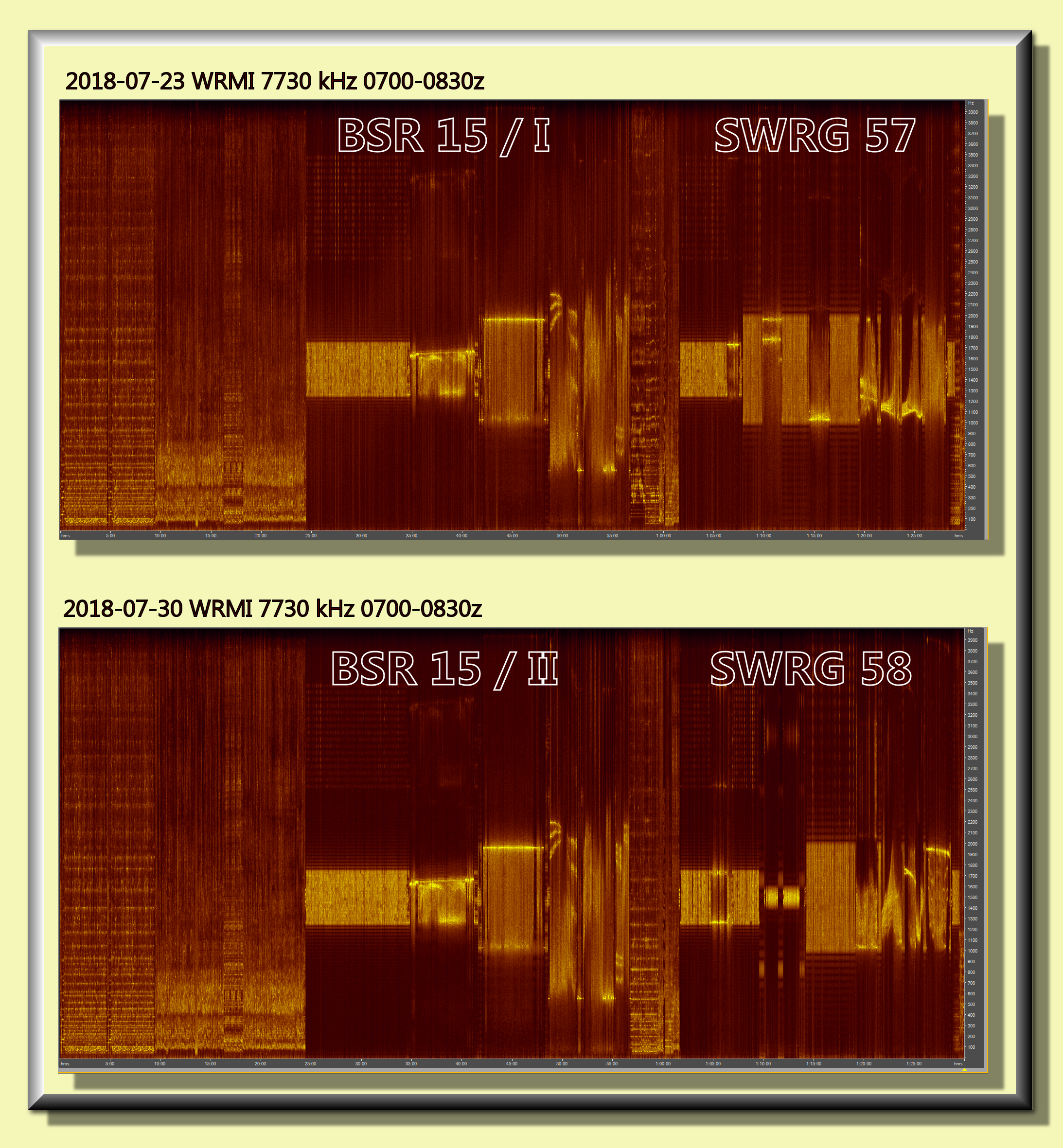
RSID: <<2018-07-30T07:30Z
MFSK-32 @
7730000+1500>>
Welcome to the BSR Radiogram
a production of James M. Branum, KG5JST and
BroadSpectrumRadio.com
for Broadcast on the week of July 23-29, 2018
Please send QSL reports to us at
broadspectrumradio@gmail.com or post them to the facebook group for our
friends at the facebook group
for the Shortwave Radiogram at:
https://www.facebook.com/groups/567099476753304/
In this episode...
1. A programming updates
2. Amateur radio special event station W5G, commemorating the 101st anniversary
of the Oklahoma Green Corn Rebellion
3. Photos and other information about the Oklahoma Green Corn Rebellion of 1917
1. Programming Update
A few things I should mention...
A. Our mailbag show is delayed for one more week. If you want to be mentioned on
this program, please send us your qsl report at
broadspectrumradio@gmail.com.
B. This program has several different modes, instead of our usual MFSK32 only.
C. We will continue on our regularly scheduled frequency and time on WRMI for
next week but after that we may be making some changes on
our programming schedule, due to both our finances and some issues. Ideally, we
are hoping to expand our schedule and broadcast coverage,
but it will hinge on how our fundraising goes. We will post details soon on our
website at broadspectrumradio.com
2. W5G, amateur radio special event station
In celebration of the 101st anniversary of the Oklahoma Green Corn Rebellion,
yours truly (KG5JST) will be opperating a ham radio special
event station under the call sign ofW5G. The station will operate from August
1-13, 2018, primarily on the FT-8 mode, but also on SSB on 10
and 20 meters and also locally on on the 2 meters and 70 cm bands. We will post
details of our operations on QRZ and on GreenCorn.org. A
special QSL card (either in electronic or postal formats) will be sent out.
3. The Oklahoma Green Corn Rebellion of 1917
This is adapted from the "about" page of the GreenCorn.org website:
Almost 101 years ago, in early August 1917, between 800-1000 people (including
impoverished African-American, European-American and
Native Americans), gathered at the farm of Joe and John Spears in Sasakawa,
Oklahoma, to plan a march upon Washington to stop the draft
(conscription for military service) and end US involvement in what would later
be called World War I. But this march didn’t happen, as word had
already spread of the plans for this march to the authorities.
Local and state authorities moved quickly to stop this movement, but it wasn’t a
shooting war until shots were fired by some of the rebels at
the Seminole County sheriff and his deputy near the Little River (near Sasakawa)
on Thursday, August 2, 1917, and not longer after that,
telephone lines were cut and attempt was to blow up a key railroad bridge.
The truth of the details of what happened after this point is shrouded in
mystery and conflicting eye-witness statements, but what can be said
with some degree of accuracy is that local and state authorities, as well as
hundreds of members of armed possees, some coming from as far
away as Oklahoma City, converged and crushed the rebellion. Three people were
killed, and 450 were arrested. Of those arrested, 266 were
released with charges being filed. Of the remaining 184 participants who wre
charged, 150 were either convicted or pleaded guilty, receiving
jail and prison terms ranging from 60 days to 10 years. But most served far less
than the original sentences with the final five held at the
Federal prison in Leaveworth, Kansas in Feburary 1922.
The aftermath of the rebellion was a radical change in Oklahoma politics, which
included a severe crackdown on the Socialist Party of
Oklahoma and the Industrial Workers of the World (both of which had not been
involved in the Green Corn Rebellion). There was also a
crackdown on all forms of dissent against the draft and World War I, and a large
scale orientation of Oklahoma politics towards the right — a
major change in a state which had once had the strongest and most active
Socialist Party in the USA.
In the years since the Green Corn Rebellion, this story has been either laughed
at (as an example of the early naivete of Oklahomans) or
ignored. High School Oklahoma History classes have talked about the events of
this era, but often in a biased and/or cursory manner, and it
has largely been out of the public discourse.
This is why a loose committee of folks has decided to create this website. We
want to tell the story, but also go further and explore how others
have told the story through our history and encourage members of the public, but
especially fellow Okies, to reflect on this event and share
those reflections in whatever form seems best— essays, poems, songs, visual art,
academic papers, etc. We also hope to spark a series of
events across Oklahoma in which ordinary folks can discuss and remember what
happened.
One big task we have is to try to gather as much archival materials about the
GCR as possible, which will include newspaper clippings, etc.
Thankfully this material is in the public domain given its age, but we still
have to find it. So please check back often as we will be adding content
on a very regular basis.
Lots of views will be expressed and some of them will be ones that we (either
collectively or as individuals) might disagree with. We are ok with
disagreement and discussion and hope you as the reader can as well. But what are
not ok with is forgetting this historical moment when
oppressed people took action to protect their rights to not fight in a war they
didn’t believe in. This story needs to be told.
The following words stand out an explanation of why we insist on telling this
misunderstood and ignored story. The words are from an elderly
Seminole-Muscogee Creek woman whose uncle had been imprisoned after the
rebellion:
“The full moon of late July, early August it was, the Moon of the Green Corn. It
was not easy to persuade our poor white and black brothers and
sisters to rise up. We told them that rising up, standing up, whatever the
consequences, would inspire future generations. Our courage, our
bravery would be remembered and copied. That has been the Indian way for
centuries, since the invasions. Fight and tell the story so that
those who come after or their descendants will rise up once again. It may take a
thousand years, but that is how we continue and eventually
prevail.” – (as quoted by Roxanne Dunbar-Ortiz in “Growing up Okie – and
Radical” in Alternative Oklahoma: Contrarian Views of the Sooner
State (2007, ed. Davis D. Joyce)
We seek to honor the wish of this elder by telling the story in the hopes that
it will inspire creative thought and action. The struggles of the
future may or may not look like the struggles of the Green Corn Rebel of 1917,
but those who struggle in the future will benefit from learning
about the struggles of the past. And that is why we are committed to telling
this story and reflecting upon it.
RSID: <<2018-07-30T07:40Z
MFSK-32 @
7730000+1500>>
Sending Pic:800x483;
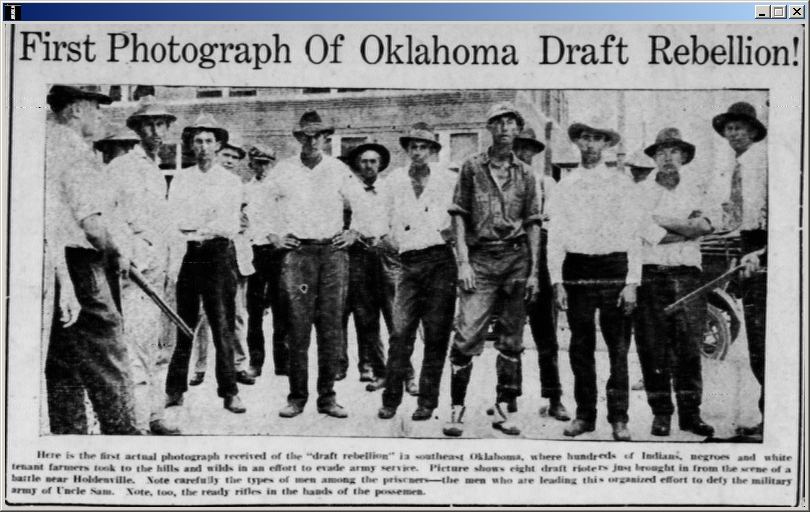
RSID: <<2018-07-30T07:47Z
MFSK-32 @
7730000+1500>>
Sending Pic:826x453C;
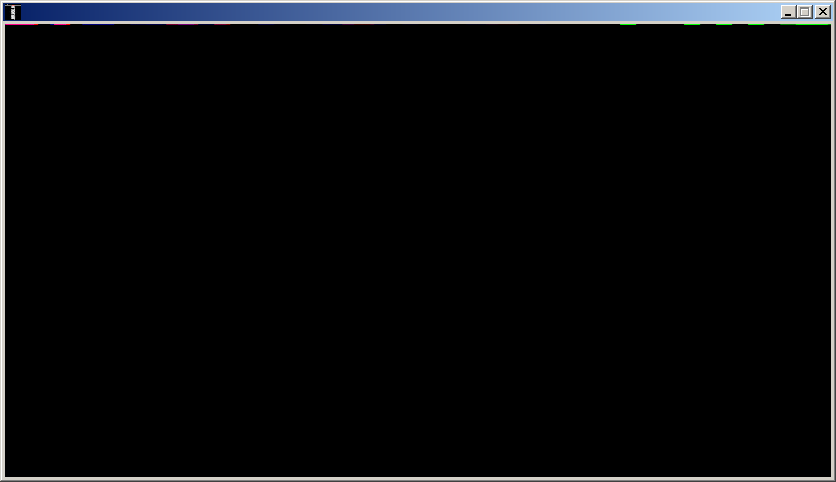
abort of the
transmission (3 x 826 x 453 px = 3 x
374178 ms = 3 x 374 s = 1122 s = 18 min 42s for 1 colored pic)
RSID: <<2018-07-30T07:47Z
MFSK-32 @
7730000+1500>>
Sending Pic:826x453;
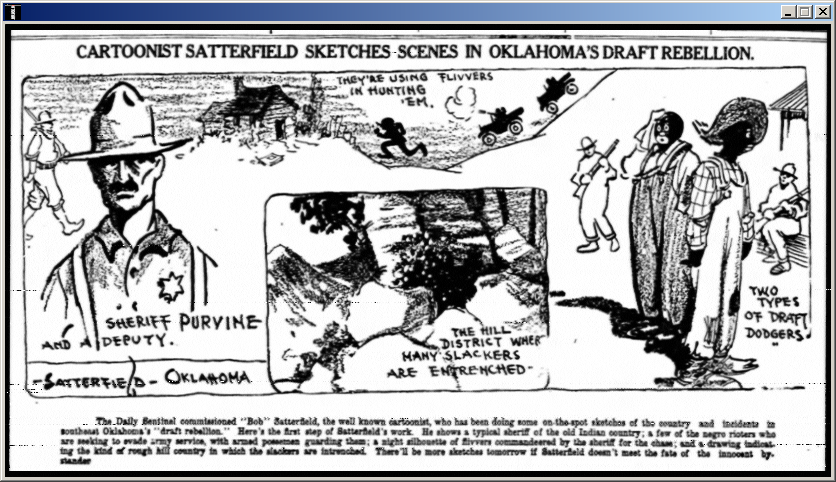
RSID: <<2018-07-30T07:54Z
MFSK-32 @
7730000+1500>>
RSID: <<2018-07-30T07:54Z
MFSK-128 @
7730000+1500>>
Sending Pic:300x210C;
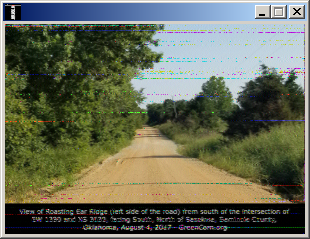
Sending Pic:203x300C;
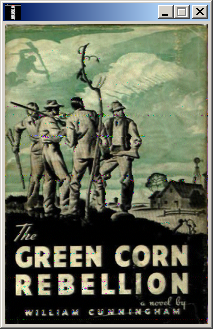
Sending Pic:130x200C;
